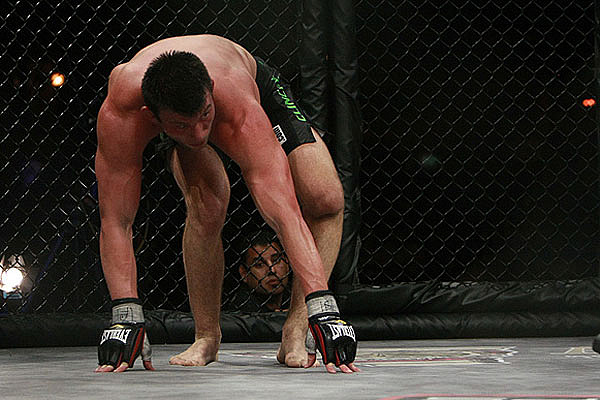The Doggy Bag: The Injury Edition
The Injury Edition

Everyone answers to somebody, so we, the staff at Sherdog.com, have decided to defer to our readers.
“The Doggy Bag” gives you the opportunity to speak about what is on your mind from time to time. Our reporters, columnists, radio hosts and editors will chime in with their answers and thoughts, so keep the emails coming.
Advertisement
For starters, are there actually more injuries happening or are there simply more bouts that we're learning about faster? What does it mean that so many high-profile fighters have been put on the sidelines and, more pressingly, will the road back to the top for some of those superstars be more difficult than others?
Injuries have had their ripple effect, too. After all, the UFC is
still trying to make this Fox deal work. Does a Brandon Vera
headliner on primetime network television really compute in 2012?
What about the curious fact that these injuries seemed to crop up
more noticeably when comprehensive medical coverage came into
effect?
If it is these answers that you seek, we advise you to read these five pages and call us in the morning.
In regards to the incredible number of bouts leading to injury cancellation, do you think part of the problem is a need for MMA media outlets to report information more quickly? Obviously, more fighters are pulling out of bouts at a greater pace right now, but in the past, the finalized event roster wasn't known until closer to the event. It's reasonable to think that there were fights that were supposed to happen but didn't without the mainstream market knowing anything about them. -- Aaron from Chicago
Jordan Breen, administrative editor: Firstly, I find it strange that the media's need to report quickly in this case is basically being charged with getting people's hopes up while fights are in the research-and-development stage. Would it be better if we waited until after an event and then released flow charts of each bout, and how they developed in the figurative notebooks of Joe Silva and Sean Shelby?
Seriously, though, it is not just that bouts are being firmed up sooner. It is entirely true that the UFC sketches out its bouts much further in advance now. Though this is partly because it is prudent to give the fighters time to prepare, it is also largely because there are so many events, so many fighters on the roster and so many contractual obligations that the UFC's matchmakers need to get their ducks in a row as soon as possible. The blowback, obviously, is that it provides fighters a longer window to get hurt -- whether in training or not -- prior to a bout.
However, it would be wrong to read that as the only issue in play here. Although the recent run of injuries we've had seems totally out of the ordinary, the UFC has dealt with tons of injury issues before.New fans to the sport might not realize this, but there was a time when Tito Ortiz-Vitor Belfort was the hot ticket fight at 205 pounds. It took almost four years to happen and by the time it did it wasn't even for a title anymore. It was supposed to happen at UFC 33; we got Vladimir Matyushenko instead. It was supposed to happen again at UFC 36 but got nixed due to Ortiz's knee injury.
That in and of itself is a noteworthy and telltale sign: UFC 36's headliner between Randy Couture and Josh Barnett was actually a replacement main event of sorts, as Barnett was coming off of knee surgery and expecting a later date. When would this ever happen today? Never, of course. A fight of that magnitude, title bout or not, would have already been irrevocably promised to a big Fox card or pay-per-view.
However, that was a decade ago. The UFC had a couple dozen fighters. Zuffa now has more than 300 fighters on its roster. There once was five divisions; now there are eight. That's nearly double the amount of potential champions that can get hurt and screw up perfect planning. The more moving parts, the more complicated the machine, the more chances something might break. Hell, it seemed like just yesterday that people were griping about UFC 108 and the intense plague of injuries going around at the time.
There needs to be something said for exceptionalism. There are, undoubtedly, a ton of injuries pullouts now. There are many, many reasons why: more fighters to get hurt, MMA fighters all being of a higher caliber making for a more competitive gym experience, the threat of losing while injured and the harm it could cause, the fact that more cards mean it is much easier to get back into action than it was a decade ago if you got hurt.
However, what really makes this period in time seem so much worse is the fact that a bigger-but-largely-unknown talent pool and many, many more cards means so much more is riding on established names and headliners in creating the "value" of an event. This odd period in infirmity has seen many of those notable fighters, those pillar pieces, get hurt. That creates a double whammy scenario. Everything is riding on those well-known, excitement-producing drawing cards -- be it champions, Top 10 athletes or beloved action fighters -- and they're the ones getting hurt. It creates a mindwarp where it seems as though there's some kind of poison coursing through the sport's veins.
Long story short: the presence of more cards means more fighters and more fighters means more people getting hurt. However, the present shouldn't be characterized by the amount of injuries alone. It isn't about people getting hurt; it is about who is getting hurt. MMA fans' favorite toys are broken, and that is always a recipe for tears.
Continue Reading » Page Two: A ‘Rush’ Back to the Top?
Related Articles






